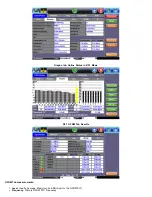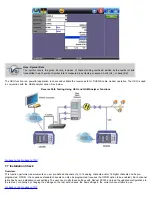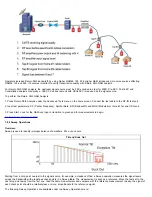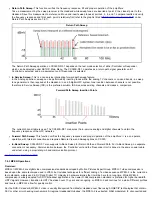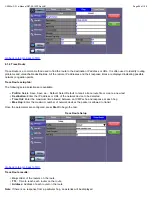
Return Path Sweep:
This function verifies the frequency response, tilt and proper operation of the amplifiers.
Take a measurement by the sweep receiver in the Headend while sweep tones are inserted at point 2; the closest point to the
Headend. Save this measurement as reference. Move and insert sweep tones at points 4, 5, 6, and 7, compare results and verify
the frequency response and tilt at each point is relatively flat (refer to the graphic titled "
" under
Return Path Analysis section 7.8.1).
Return Path Sweep
The Return Path Sweep operation on CX380S-D3.1 depends on the test mode selection of either Controller or Responder,
which can be selected under SETUP, Main Menu. The CX380S-D3.1 operates as a return path signal generator unit if
Controller is selected, and a measurement unit if Responder is selected.
In Service Sweep:
This is a non service interrupting forward path sweep feature.
In the Analog spectrum, sweep can be performed by inserting tones within the analog TV channels or un-used bands - a sweep
tone generator is then required at the Headend. In an all-digital HFC system, tone insertion between channels is not possible,
therefore In Service Sweep (ISS) is the preferred solution. ISS measures existing channels and makes a comparison.
Forward Path Sweep Insertion Points
The current channel table is used. The CX380S-D3.1 measures the in-service analog and digital channels to obtain the
frequency response of the HFC networks.
Forward Path Sweep:
This function verifies the frequency response and proper operation of the amplifiers. It is a one person
operation with Internet connection and requires Remote View and Sweep options on CX380.
In-Band Sweep:
CX380S-D3.1 also supports In-Band Sweep for Return Path and Forward Path. For In-Band Sweep, no separate
connection is necessary. Communication between the 'Controller' unit and the 'Responder Unit is done via the same coaxial cable
under test, using a proprietary in-band communication protocol.
7.8.3 MPEG Operations
Overview:
MPEG-1/ MPEG-2 are digital video compression standards developed by Motion Pictures Expert Group. MPEG-1 video compression is
based upon the same technique used in JPEG, but includes techniques for efficient coding of a video sequence. MPEG-2 is the current de
facto standard, widely used in DVD and Digital TV. Ubiquity in hardware implies that it will be here for a long time. While MPEG-2
compression is widely adopted for SDTV broadcast applications, the newer H.264 compression standard is preferred for higher bandwidth
HDTV signals. However, transition to HDTV has taken over 13 years and is ongoing, so MPEG-2 will continue for a while. Different profiles
and levels in MPEG-2 allow for quality control.
Per the DVB-C standard, MPEG-2 video is usually transported from Master Headend over fiber using SONET/IP technologies that contain
FEC or other error checking mechanisms. At regional Headends/Hub sites, the MPEG-2 is extracted, QAM modulated, IF unconverted and
Содержание VEPAL CX350S-D3.1
Страница 1: ...CX350s D3 1 e Manual D07 00 102P RevA01 Page 1 of 109 ...
Страница 13: ...Go back to top Go back to TOC CX350s D3 1 e Manual D07 00 102P RevA01 Page 13 of 109 ...
Страница 16: ...Go back to top Go back to TOC CX350s D3 1 e Manual D07 00 102P RevA01 Page 16 of 109 ...
Страница 21: ...Go back to top Go back to TOC CX350s D3 1 e Manual D07 00 102P RevA01 Page 21 of 109 ...
Страница 57: ...Go back to top Go back to TOC 7 8 4 Remote Operations ...
Страница 70: ...Trace Route Result Go back to top Go back to TOC CX350s D3 1 e Manual D07 00 102P RevA01 Page 65 of 109 ...
Страница 76: ...Go back to top Go back to TOC CX350s D3 1 e Manual D07 00 102P RevA01 Page 71 of 109 ...









